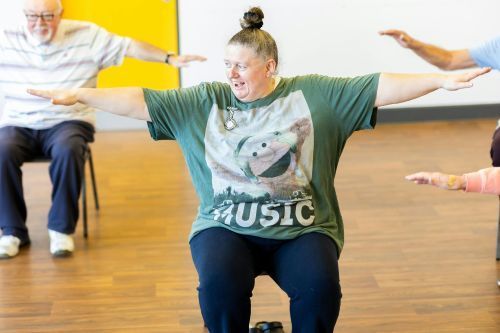Managing Chronic Conditions with Exercise
Managing Chronic Conditions with Exercise

Chronic conditions such as arthritis, diabetes, heart disease, and osteoporosis can significantly impact the quality of life for seniors. However, regular exercise is a powerful tool that can help manage these conditions, reduce symptoms, and improve overall well-being.
At Key to Life Health and Fitness, we offer tailored fitness programs designed to support seniors with chronic conditions. Here’s how exercise can help manage chronic conditions and some tips to get started:
Benefits of Exercise for Managing Chronic Conditions
1. Improved Cardiovascular Health: Regular exercise helps strengthen the heart and improve circulation, which is particularly beneficial for seniors with heart disease. Activities like walking, swimming, and cycling can help lower blood pressure and reduce the risk of heart attacks and strokes.
2. Better Blood Sugar Control: For seniors with diabetes, exercise can help regulate blood sugar levels by improving insulin sensitivity. Strength training and aerobic exercises are especially effective in managing diabetes and preventing complications.
3. Reduced Joint Pain and Improved Mobility: Exercise is essential for managing arthritis and other joint-related conditions. Low-impact exercises like swimming, yoga, and Pilates can help reduce joint pain, increase flexibility, and improve range of motion.
4. Increased Bone Density: Weight-bearing exercises such as walking, dancing, and strength training can help increase bone density and reduce the risk of osteoporosis. Regular exercise also helps improve balance and coordination, reducing the risk of falls and fractures.
5. Enhanced Mental Health: Exercise releases endorphins, which can improve mood and reduce symptoms of depression and anxiety. Physical activity also promotes better sleep and cognitive function, enhancing overall mental well-being.
Tips for Exercising with Chronic Conditions
1. Consult Your Doctor: Before starting any new exercise routine, it’s important to consult with your doctor. They can provide guidance on what types of exercises are safe and appropriate for your specific condition.
2. Start Slow and Gradual: Begin with low-impact exercises that are gentle on your body. Gradually increase the intensity and duration of your workouts as your fitness level improves. Listen to your body and avoid pushing yourself too hard.
3. Focus on Consistency: Consistency is key to managing chronic conditions with exercise. Aim to incorporate physical activity into your daily routine and make it a regular habit. Even small amounts of exercise can make a big difference over time.
4. Incorporate a Variety of Exercises: A well-rounded fitness routine should include aerobic, strength, flexibility, and balance exercises. This variety helps target different aspects of fitness and provides comprehensive benefits for managing chronic conditions.
5. Stay Hydrated and Eat Well: Proper nutrition and hydration are essential for optimal performance and recovery. Drink plenty of water before, during, and after your workouts, and eat a balanced diet rich in fruits, vegetables, lean proteins, and whole grains.
5. Listen to Your Body: Pay attention to how your body feels during and after exercise. If you experience pain, dizziness, or shortness of breath, stop immediately and consult your doctor. It’s important to recognize the difference between normal muscle soreness and pain that could indicate injury.
At Key to Life Health and Fitness, our experienced trainers provide personalized guidance to help seniors manage chronic conditions through exercise. Our senior fitness classes are designed to accommodate individual needs and fitness levels, ensuring a safe and effective workout.
Ready to improve your health through exercise? Contact Key to Life Health and Fitness today to learn more about our senior fitness classes and personalized training programs. Let’s work together to manage chronic conditions and enhance your quality of life! 🌟







